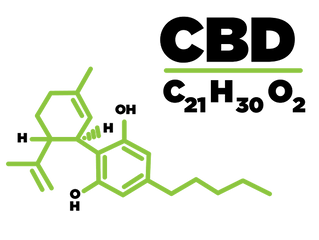The Endocannabinoid System (ECS) refers to a series of receptors and their corresponding molecules. Two primary receptors make up the ECS; Cannabinoid Receptor 1 (CB1) and Cannabinoid Receptor 2 (CB2).
There are two main endocannabinoid molecules which are named anandamide and 2-Ag. Scientists would have never discovered anandamide without THC. THC was discovered by Scientist Raphael Mechoulam in the 1960s. His finding quickly created a mad rush to understand how THC worked and whether or not our bodies produced a similar compound. Fast forward 20 years later and anandamide was found! It’s has been called the “bliss molecule.” Eventually, anandamide was found to do much more than produce a state of blissfulness. It also plays an important role in regulating pain, appetite, and fertility and it assists in slowing cancer cell proliferation.
Cannabinoid receptors are found all throughout the body but certain receptors are more concentrated in specific regions. Anxiety, PTSD, and other mood disorders reflect a central nervous system primarily with CB1 receptors. Cannabinoids bind to the amygdala, which is the portion of the brain responsible for emotions, and make the neurons in the brain less active.
For those who suffer from autoimmune diseases or digestive issues, it’s the CB2 receptors that will determine how the body feels and responds. Researchers have demonstrated that CB2 is used to help animals and humans cope with unexpected injury, or generalized pain and inflammation.
You’ll find both CB receptors in the brain, though the concentration of CB1 receptors is much higher than CB2. THC generally activates CB1 receptors, while CBD activates CB2 receptors. The presence of CB1 receptors in the brain partially explains why THC produces psychoactive effects while CBD does not.
Endocannabinoids help regulate the following:
Sleep
Appetite, digestion & hunger
Mood
Motor control
Immune function
Reproduction and fertility
Pleasure and reward
Pain
Memory
Temperature regulation
Endocannabinoids are critical in maintaining homeostasis. A disrupted ECS can result in any of these things listed above to become out of balance and can contribute to a wide variety of conditions like Fibromyalgia, for instance.
This theory is called “Clinical Endocannabinoid Deficiency“. What that means is when the body doesn’t produce adequate amounts of endocannabinoids you are more susceptible to illnesses that affect any of the functions listed above.
Cannabinoid receptors are often what we associate with the endocannabinoid system but enzymes also play a crucial role. Enzymes basically consume various compounds, alters them and then eliminates the parts. In the ECS, enzymes break down leftover endocannabinoids. This is where CBD comes in! THC binds with cannabinoid receptors directly, CBD instead works it’s magic on an enzyme. The enzyme I’m referring to is called FAAH, and it’s responsible for eliminating excess anandamide out of circulation. CBD halts this process. THC mimicks the body’s own endocannabinoids whereas CBD increases the amount of endocannabinoids in your system.
Because CBD stops enzyme FAAH from breaking down the anandamide, more of it is available for use by your cells. Hence the reason CBD is a natural mood-lifter without the psychoactive effects.
Every year more and more studies are shedding light into how critical the Endocannibinoid System is in our bodies. The discovery of the ECS is exactly why medical cannabis is such a big deal. The plant heals a variety of seemingly completely unrelated conditions when in fact, it is now understood these conditions are all regulated in some way by the ECS. The medical implications of this are endless!
Tags:

